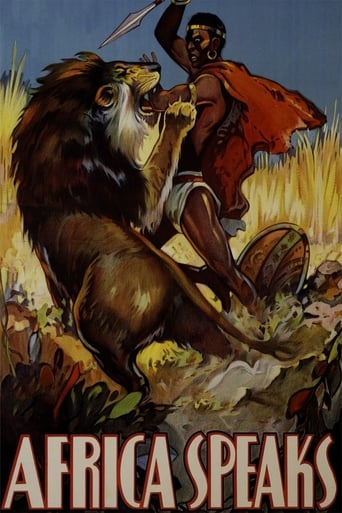TeenzTen
An action-packed slog
ShangLuda
Admirable film.
Iseerphia
All that we are seeing on the screen is happening with real people, real action sequences in the background, forcing the eye to watch as if we were there.
Bessie Smyth
Great story, amazing characters, superb action, enthralling cinematography. Yes, this is something I am glad I spent money on.
MartinHafer
In some ways, there is a lot to like about this documentary. After all, it's one of the film to use sound footage--after many previous silent African safari films. In addition, the footage is excellent--well filmed and not chock full of stock footage like some documentaries. I liked seeing and learning about the pygmy tribes and the various animals. However, at the same time, there is an often annoying narration. Too often, the narrator tries to sound clever--making terribly unfunny jobs and supposedly glib comments. But they all come off badly and seem, at times, a bit condescending towards the subject matter--though I must also admit that the narration about the pygmies is not. It's really a shame, as with better narration, this would have been an exciting film to watch---especially since I learned some wonderful things about the animals and people of this continent....when I wasn't groaning at the narration! If you want to see it, follow the link on IMDb and you can copy it free to your hard drive since it's in the public domain.
fbmorinigo
September 4, 2008, I saw this again after sixty plus years, in an Internet Archive copy that has only 50 of the original 75 minutes, and was mesmerized to realize how much of my concept of Africa is due to this movie. Rivers, canoes, safaris, multiple tribes, locusts, lions, wildebeest, giraffes, impalas, elephants, flamingoes, warthogs are all here, in the heat. The sequence on the jumping impalas was most impressive to me now, as I recall nothing like it in any other movie. The only warning to the modern viewer is that the narration, while lively and fascinatingly informative, contains comments, evaluations and comparisons that seem shockingly inappropriate. Clearly this movie had an enormous influence on movie-making, from "King Kong" through "The Living Desert" to "The Lion King". This movie is the successful ancestor of anything you see on Animal Planet and most of Discovery Channel.
pmcenea
This film is striking for several reasons. The obvious footage of animals and insects was magnificent, and so was the scenes of the veldt, regardless of the animals. But, beyond that, the whole feeling of the daily hardship of life on the African continent 70 odd years ago was almost overwhelming. This film brought the living in fear of lions, locust, tsetse flies and other dangers into sharp relief for me. It was well worth watch if only to get the historical sense of life on the dark continent.
rsoonsa
In order to bring this important early sound era documentary into proper cultural and natural historic focus, one must bethink of the prodigious changes that have altered the face of Africa as well as its humanity and fauna during the more than 70 years since the film's production. One can only imagine the reaction of a 1930 audience which viewed the extraordinary events presented and filmed by Colorado-based explorer Paul Hoefler, including the death and mealtaking by a family of lions of one of Hoefler's expeditionary native assistants, total decimation of the expedition's surrounding flora by a massive winged horde of locusts, and remarkable animals and people of many varieties. Narrator Lowell Thomas' somewhat casual comments of events that could not have been greeted in such cavalier fashion at the time they occurred can be offputting, and his attempts at whimsy consistently fall as flat as the veldt being traversed, but withal the narration provides a raft of historically fascinating data. Hoefler's book of the same title, published shortly after the release of the film, differs insofar as the expedition actually travelled from east to west, rather than the reverse, but for purposes of visual impact actual events were edited in order to produce dramatic action.

